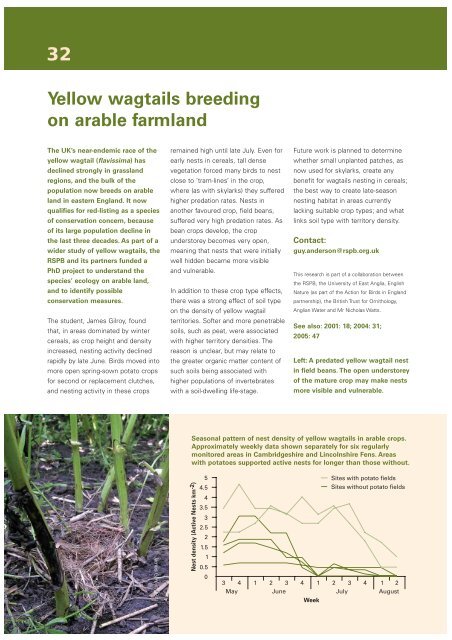Conservation Science in the RSPB 2006
Conservation Science in the RSPB 2006
Conservation Science in the RSPB 2006
You also want an ePaper? Increase the reach of your titles
YUMPU automatically turns print PDFs into web optimized ePapers that Google loves.
32<br />
Yellow wagtails breed<strong>in</strong>g<br />
on arable farmland<br />
The UK’s near-endemic race of <strong>the</strong><br />
yellow wagtail (flavissima) has<br />
decl<strong>in</strong>ed strongly <strong>in</strong> grassland<br />
regions, and <strong>the</strong> bulk of <strong>the</strong><br />
population now breeds on arable<br />
land <strong>in</strong> eastern England. It now<br />
qualifies for red-list<strong>in</strong>g as a species<br />
of conservation concern, because<br />
of its large population decl<strong>in</strong>e <strong>in</strong><br />
<strong>the</strong> last three decades. As part of a<br />
wider study of yellow wagtails, <strong>the</strong><br />
<strong>RSPB</strong> and its partners funded a<br />
PhD project to understand <strong>the</strong><br />
species’ ecology on arable land,<br />
and to identify possible<br />
conservation measures.<br />
The student, James Gilroy, found<br />
that, <strong>in</strong> areas dom<strong>in</strong>ated by w<strong>in</strong>ter<br />
cereals, as crop height and density<br />
<strong>in</strong>creased, nest<strong>in</strong>g activity decl<strong>in</strong>ed<br />
rapidly by late June. Birds moved <strong>in</strong>to<br />
more open spr<strong>in</strong>g-sown potato crops<br />
for second or replacement clutches,<br />
and nest<strong>in</strong>g activity <strong>in</strong> <strong>the</strong>se crops<br />
rema<strong>in</strong>ed high until late July. Even for<br />
early nests <strong>in</strong> cereals, tall dense<br />
vegetation forced many birds to nest<br />
close to ‘tram-l<strong>in</strong>es’ <strong>in</strong> <strong>the</strong> crop,<br />
where (as with skylarks) <strong>the</strong>y suffered<br />
higher predation rates. Nests <strong>in</strong><br />
ano<strong>the</strong>r favoured crop, field beans,<br />
suffered very high predation rates. As<br />
bean crops develop, <strong>the</strong> crop<br />
understorey becomes very open,<br />
mean<strong>in</strong>g that nests that were <strong>in</strong>itially<br />
well hidden became more visible<br />
and vulnerable.<br />
In addition to <strong>the</strong>se crop type effects,<br />
<strong>the</strong>re was a strong effect of soil type<br />
on <strong>the</strong> density of yellow wagtail<br />
territories. Softer and more penetrable<br />
soils, such as peat, were associated<br />
with higher territory densities. The<br />
reason is unclear, but may relate to<br />
<strong>the</strong> greater organic matter content of<br />
such soils be<strong>in</strong>g associated with<br />
higher populations of <strong>in</strong>vertebrates<br />
with a soil-dwell<strong>in</strong>g life-stage.<br />
Future work is planned to determ<strong>in</strong>e<br />
whe<strong>the</strong>r small unplanted patches, as<br />
now used for skylarks, create any<br />
benefit for wagtails nest<strong>in</strong>g <strong>in</strong> cereals;<br />
<strong>the</strong> best way to create late-season<br />
nest<strong>in</strong>g habitat <strong>in</strong> areas currently<br />
lack<strong>in</strong>g suitable crop types; and what<br />
l<strong>in</strong>ks soil type with territory density.<br />
Contact:<br />
guy.anderson@rspb.org.uk<br />
This research is part of a collaboration between<br />
<strong>the</strong> <strong>RSPB</strong>, <strong>the</strong> University of East Anglia, English<br />
Nature (as part of <strong>the</strong> Action for Birds <strong>in</strong> England<br />
partnership), <strong>the</strong> British Trust for Ornithology,<br />
Anglian Water and Mr Nicholas Watts.<br />
See also: 2001: 18; 2004: 31;<br />
2005: 47<br />
Left: A predated yellow wagtail nest<br />
<strong>in</strong> field beans. The open understorey<br />
of <strong>the</strong> mature crop may make nests<br />
more visible and vulnerable.<br />
Seasonal pattern of nest density of yellow wagtails <strong>in</strong> arable crops.<br />
Approximately weekly data shown separately for six regularly<br />
monitored areas <strong>in</strong> Cambridgeshire and L<strong>in</strong>colnshire Fens. Areas<br />
with potatoes supported active nests for longer than those without.<br />
James Gilroy (UEA)<br />
Nest density (Active Nests km -2 )<br />
5<br />
4.5<br />
4<br />
3.5<br />
3<br />
2.5<br />
2<br />
1.5<br />
1<br />
0.5<br />
0<br />
Sites with potato fields<br />
Sites without potato fields<br />
3 4 1 2 3 4 1 2 3 4 1 2<br />
May June July August<br />
Week

















